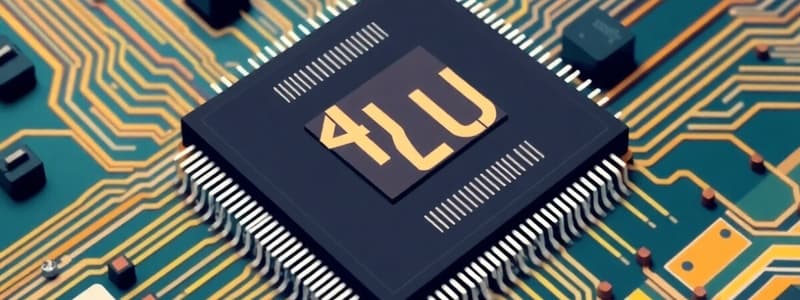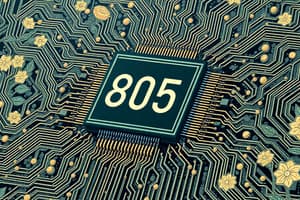Podcast
Questions and Answers
What is the primary function of the Arithmetic and Logic Unit (ALU) in a microprocessor?
What is the primary function of the Arithmetic and Logic Unit (ALU) in a microprocessor?
- To provide control signals to different segments of the microprocessor
- To store data temporarily during program execution
- To perform mathematical computations and logical decisions (correct)
- To hold the address of the next program instruction
Which component of a microprocessor holds the fetched instruction?
Which component of a microprocessor holds the fetched instruction?
- Instruction Register (IR) (correct)
- Control Unit (CU)
- Register Array
- Program Counter (PC)
How do microprocessors differ from microcontrollers in terms of user interaction?
How do microprocessors differ from microcontrollers in terms of user interaction?
- Microcontrollers perform complex computations while microprocessors focus on simple tasks.
- Microcontrollers are designed for a wide range of applications and require user interaction.
- Both are designed for maximum user interaction in embedded systems.
- Microprocessors are used in devices that seldom interact with the user, while microcontrollers do. (correct)
Which of the following is NOT a building block of an embedded controller?
Which of the following is NOT a building block of an embedded controller?
What is one of the main purposes of the Control Unit (CU) in a microprocessor?
What is one of the main purposes of the Control Unit (CU) in a microprocessor?
Which statement about microprocessors is true?
Which statement about microprocessors is true?
In terms of memory management, what role does the Direct Memory Access (DMA) control unit serve?
In terms of memory management, what role does the Direct Memory Access (DMA) control unit serve?
What is a key difference between event control and data control in embedded systems?
What is a key difference between event control and data control in embedded systems?
What is a characteristic of embedded microprocessors regarding human interaction?
What is a characteristic of embedded microprocessors regarding human interaction?
Which function does the analog to digital converter serve in an embedded microprocessor system?
Which function does the analog to digital converter serve in an embedded microprocessor system?
What is the main purpose of an embedded microprocessor?
What is the main purpose of an embedded microprocessor?
Which of the following best describes the memory capabilities of embedded microprocessors?
Which of the following best describes the memory capabilities of embedded microprocessors?
What role does the Programmable Interval Timer (PIT) play in an embedded system?
What role does the Programmable Interval Timer (PIT) play in an embedded system?
What is a key step in designing an embedded microprocessor system?
What is a key step in designing an embedded microprocessor system?
How do embedded microprocessors interact with external devices?
How do embedded microprocessors interact with external devices?
What is a feature of the Time Processing Unit (TPU) compared to simpler timers?
What is a feature of the Time Processing Unit (TPU) compared to simpler timers?
What distinguishes the data bus of the 80186 from that of the 80188 microprocessor?
What distinguishes the data bus of the 80186 from that of the 80188 microprocessor?
Which of the following features are included in both the 80186 and 80188 microprocessors?
Which of the following features are included in both the 80186 and 80188 microprocessors?
What is the primary function of the DMA controller unit in the 80186/80188 microprocessors?
What is the primary function of the DMA controller unit in the 80186/80188 microprocessors?
How many programmable timers are included in the 80186/80188 microprocessors?
How many programmable timers are included in the 80186/80188 microprocessors?
What is the role of the programmable interrupt controller in the microprocessors?
What is the role of the programmable interrupt controller in the microprocessors?
What is one of the purposes of the second timer in the programmable timers of the 80186/80188?
What is one of the purposes of the second timer in the programmable timers of the 80186/80188?
Which component acts as the master controller in the 80186 architecture?
Which component acts as the master controller in the 80186 architecture?
What does the 6-byte pre-fetch queue in the 80186 allow for compared to the 4-byte queue in the 80188?
What does the 6-byte pre-fetch queue in the 80186 allow for compared to the 4-byte queue in the 80188?
Flashcards are hidden until you start studying
Study Notes
General Purpose Processors
- Designed to solve a wide range of problems.
- Manufacturers invest heavily in their development, leading to sophisticated features.
- Specialized design tools are provided by manufacturers.
- Microprocessors are clock-driven semiconductor devices.
Building Blocks of Microprocessors
- Arithmetic and Logic Unit (ALU):
- Constructed using logic gates.
- Performs mathematical computations and logical decisions.
- Register Array:
- Consists of memory elements fabricated in the microprocessor.
- The size of the register array is used to name the microprocessor.
- Stores data temporarily during program execution.
- Program Counter (PC): Holds the address of the next program instruction.
- Instruction Register (IR): Holds the fetched instruction.
- Control Unit (CU):
- Provides control signals to different segments of the microprocessor .
- Controls the timing of operation for electronic circuits within the microprocessor.
- Retrieves program instructions and manages data flow through the data path.
Embedded Microprocessors
- VLSI chips integrated into various products.
- Used in electronic devices to perform specialized tasks with limited user interaction.
Embedded Control Applications
- Event control or real-time control: Uses microcontrollers.
- Data control: Employs embedded microprocessors.
Building Blocks of Embedded Controllers
- Data processing unit
- Data formatting unit
- I/O control unit
- Direct memory access (DMA) control unit
- Memory
- CPU
- Timer unit
Characteristics of Embedded Microprocessors
- Limited human interaction and no need for human supervision.
- Rely on stored programs and data input to manage behavior.
- Interact with environments through an interrupt system.
- Interrupts are signals from devices, indicating the need for processor attention.
- Processor enters an interrupt program and decodes the source to handle the interrupt appropriately.
- Programs are stored in memory, typically limited in size.
- Programs executed by embedded microprocessors tend to be short.
- Utilize a variety of on-chip devices for functionality.
- May need to accept input from external devices through analog to digital converters (ADCs).
- ADCs convert analog signals into digital data for processing.
- Digital to analog converters (DACs) allow processors to send signals to controlled devices.
Common Embedded Microprocessor Timers
- Programmable Interval Timer (PIT): Counts down from a preset value to zero and triggers an interrupt.
- Time Processing Unit (TPU): More sophisticated timer capable of detecting input events and generating output events.
Designing Embedded Microprocessor Systems
- Steps:
- Product requirement definitions
- Functionality description
- Processor selection
- Hardware design
- Firmware design
- Integration
- Iteration and flexibility are crucial in the process.
- Hardware construction, code writing, and system debugging are essential aspects.
- State transition diagrams, flowcharts, state and dataflow diagrams are useful design aids.
- Debugging hardware and software is crucial, and debug facilities should be easily incorporated.
Intel 80186/80188 Microprocessor Architecture
- Key Difference:
- 80186: 16-bit data bus.
- 80188: 8-bit data bus.
- Both processors:
- 80186: 6-byte pre-fetch queue.
- 80188: 4-byte pre-fetch queue.
- Additional reserved interrupt vectors and powerful built-in I/O features.
Special Features of Intel 80186/80188
- DMA controller unit: Facilitates data transfer between I/O devices and memory.
- Three programmable timers:
- 16-bit timer/counters.
- Two timers used for:
- Counting external events.
- Generating waveforms based on external or CPU clocks.
- Interrupting the CPU after a specific number of events.
- Third timer counts CPU clock cycles.
- Can also interrupt the CPU after a set number of clock cycles.
- Provides a DMA request pulse to the DMA unit.
- Programmable interrupt controller:
- Handles interrupt requests from internal and external sources.
- Interrupts cause temporary halts during program execution, allowing peripheral devices access to the microprocessor.
- The processor responds with an Interrupt Service Routine (ISR), a program that handles the interrupt.
- Two 8259A interrupt controller chips can be cascaded with the integrated 80186 interrupt controller.
- The interrupt controller serves as the master controller.
Studying That Suits You
Use AI to generate personalized quizzes and flashcards to suit your learning preferences.




